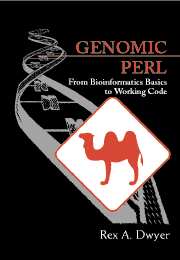Book contents
- Frontmatter
- Contents
- Preface
- Acknowledgments
- 1 The Central Dogma
- 2 RNA Secondary Structure
- 3 Comparing DNA Sequences
- 4 Predicting Species: Statistical Models
- 5 Substitution Matrices for Amino Acids
- 6 Sequence Databases
- 7 Local Alignment and the BLAST Heuristic
- 8 Statistics of BLAST Database Searches
- 9 Multiple Sequence Alignment I
- 10 Multiple Sequence Alignment II
- 11 Phylogeny Reconstruction
- 12 Protein Motifs and PROSITE
- 13 Fragment Assembly
- 14 Coding Sequence Prediction with Dicodons
- 15 Satellite Identification
- 16 Restriction Mapping
- 17 Rearranging Genomes: Gates and Hurdles
- A Drawing RNA Cloverleaves
- B Space-Saving Strategies for Alignment
- C A Data Structure for Disjoint Sets
- D Suggestions for Further Reading
- Bibliography
- Index
8 - Statistics of BLAST Database Searches
Published online by Cambridge University Press: 05 June 2012
- Frontmatter
- Contents
- Preface
- Acknowledgments
- 1 The Central Dogma
- 2 RNA Secondary Structure
- 3 Comparing DNA Sequences
- 4 Predicting Species: Statistical Models
- 5 Substitution Matrices for Amino Acids
- 6 Sequence Databases
- 7 Local Alignment and the BLAST Heuristic
- 8 Statistics of BLAST Database Searches
- 9 Multiple Sequence Alignment I
- 10 Multiple Sequence Alignment II
- 11 Phylogeny Reconstruction
- 12 Protein Motifs and PROSITE
- 13 Fragment Assembly
- 14 Coding Sequence Prediction with Dicodons
- 15 Satellite Identification
- 16 Restriction Mapping
- 17 Rearranging Genomes: Gates and Hurdles
- A Drawing RNA Cloverleaves
- B Space-Saving Strategies for Alignment
- C A Data Structure for Disjoint Sets
- D Suggestions for Further Reading
- Bibliography
- Index
Summary
In Chapter 7, we justified the use of fast alignment heuristics like BLAST by our need to quickly align large numbers of sequences in a database with a given query sequence to determine which were most similar to the query. In this chapter, we will consider statistical aspects of the set of alignment scores we might encounter when performing such a database search. The distribution of scores obviously depends on the substitution matrix employed (PAM30, BLOSUM62, PAM250, etc.), and a proof of the general result requires rather extensive use of sophisticated mathematical notation. We will avoid this by concentrating on a specific, simple scoring matrix for DNA before outlining the general result.
Like all but the most recent versions of BLAST, we will focus on gapless alignments. The theory of statistical properties of scores of alignments with gaps has been elucidated only approximately and only for special cases. The theory supports the empirical observation that their behavior is similar to the behavior of statistics without gaps.
BLAST Scores for Random DNA
Suppose that Q is a query sequence of DNA and that D is a sequence from a database. As usual for DNA, we will score +1 for matched bases and -1 for mismatched bases in alignments of D and Q. Suppose a BLAST search discovers a local gap-free alignment with a score of 13. Does this suggest that D and Q are in some way related, or could this be better explained by chance? To answer this question, we must define precisely what “by chance” means to us, and then compute – or at least estimate – the probability that a score of 13 or higher occurs under that definition.
Information
- Type
- Chapter
- Information
- Genomic PerlFrom Bioinformatics Basics to Working Code, pp. 109 - 126Publisher: Cambridge University PressPrint publication year: 2002
